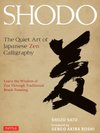Shodo: The Quiet Art of Japanese Zen Calligraphy, Learn the Wisdom of Zen Through Traditional Brush Painting
amazon.com
Saved by Lael Johnson and
Shodo: The Quiet Art of Japanese Zen Calligraphy, Learn the Wisdom of Zen Through Traditional Brush Painting

Saved by Lael Johnson and
meaning. A major distinction between the kanji writing system and an alphabet-based writing system is that a single ideogram of kanji is a “word” carrying a specific meaning.
Ichigyo mono wall hangings containing zengo are the most revered of all the items on display in the tokonoma or alcove of a tea room.
In shodo it is considered sacrilege to go back and touch up the work. Any adjustment or touch-up would be apparent, and would interrupt the ki, and therefore the created work wouldn’t be an honest representation of the artist’s energy and personality.
both the tea ceremony and Zen share the basic philosophy that all extraneous or redundant activities should be removed and in spirit and action the whole environment should reflect economy and minimalism.
In the art of sho, spirituality and physical activities have to coincide, therefore breathing control is of utmost importance.
The creative process in shodo, as in many other arts, is in many ways a “spiritual purification” of the creator.
respected Tanchiu Koji Terayama, director of Hitsu Zendo. The English translation of his book’s title is Zen and the Art of Calligraphy (transl. by John Stevens; Penguin Group, 1983).
an essential step in the preparation for a tea ceremony is looking at a work of shodo to clear one’s mind.
change in the order of strokes is acceptable, as is adjusting brush strokes to suit one’s own style, and for artistic creativity. This flexibility in gyosho allows the shodo artist the opportunity to produce remarkable works. For this reason also, most Japanese calligraphy is done in gyosho, including bokuseki writings by Zen priests.